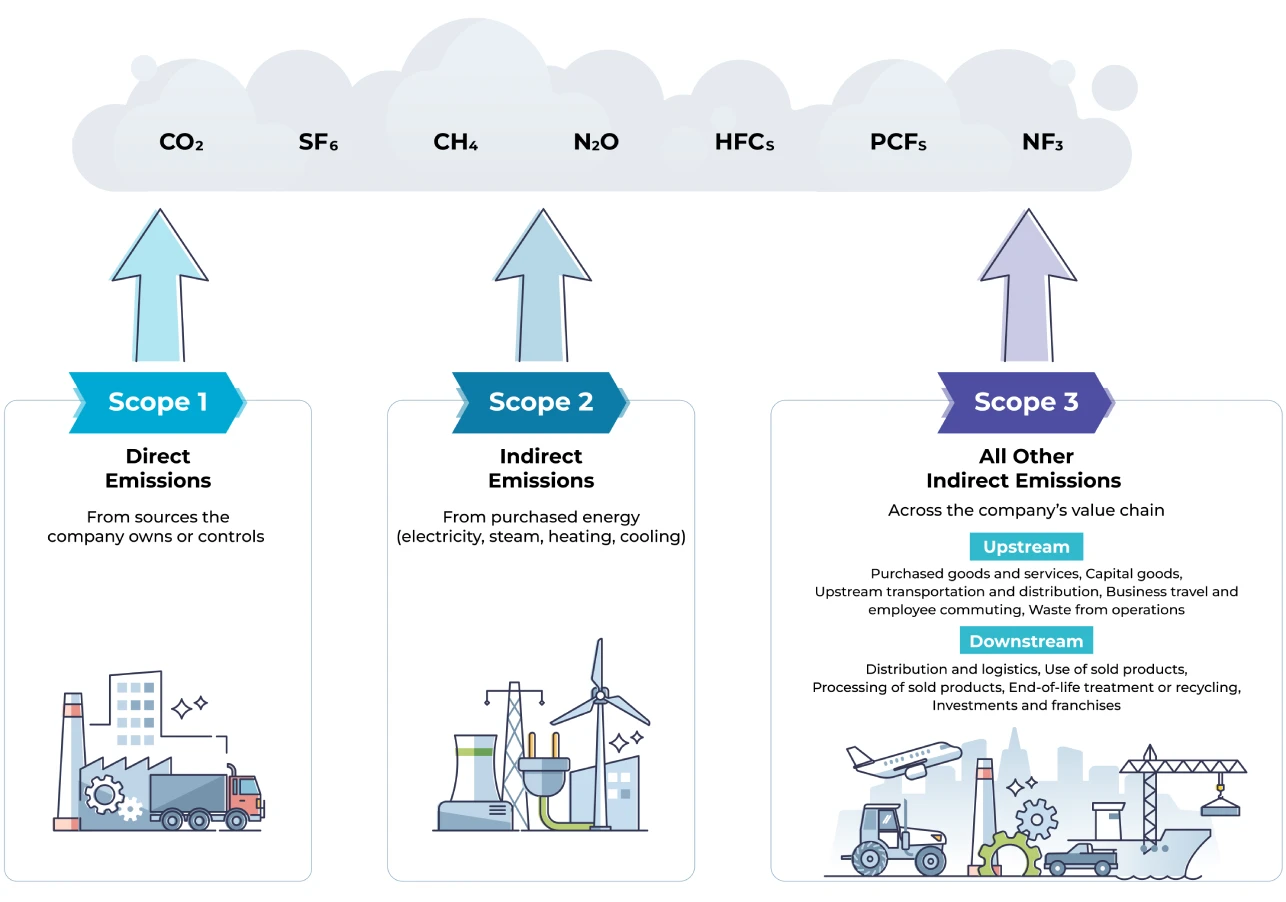What is Carbon Accounting?
Carbon accounting is the practice of measuring, tracking, and reporting greenhouse gas (GHG) emissions – both direct and indirect. By quantifying emissions, businesses gain a complete view of their carbon footprint, uncover opportunities to reduce it, and monitor progress toward net-zero goals.
But to truly understand how emissions are measured and managed, it’s important to first examine how they’re classified by source.
Classifying Emissions: Scope 1, 2, and 3
Every organization’s carbon footprint extends far beyond what’s visible within its walls. The Greenhouse Gas (GHG) Protocol — the global benchmark for carbon accounting — classifies emissions into three scopes to help companies measure, manage, and mitigate their total impact.
- Scope 1 – Direct Emissions
These come from sources a company directly owns or controls, such as fuel burned in company vehicles, manufacturing equipment, or on-site energy systems. Monitoring and optimizing these sources provides the most immediate opportunities for reduction. - Scope 2 – Indirect Emissions
Generated from the electricity, heating, cooling, or steam that a company purchases to power its operations. Transitioning to renewable energy sources and improving energy efficiency are key levers for minimizing this category. - Scope 3 – Value Chain Emissions
The most complex and far-reaching category — Scope 3 covers all other indirect emissions across your value chain, from suppliers to product use and disposal. For most businesses, this accounts for the largest share of their total carbon footprint.
How does Carbon Accounting Work?
Carbon accounting isn’t just about data collection — it’s about building a consistent, transparent framework for emissions management. The process involves four key steps:
- Categorization and scoping: Identify which business activities generate emissions and classify them under Scope 1, 2, or 3 to define clear boundaries for measurement.
- Data identification and collection: Gather data on energy use, fuel consumption, travel, waste, and procurement. Depending on the approach, this can be based on activity data (like kWh or liters of fuel) or financial data (spend-based estimates).
- Emission factor application: Convert collected data into measurable carbon emissions using standardised conversion factors from sources like the IEA emission factors database or the UK’s GHG reporting factors.
- Calculation and reporting: Quantify total emissions by:
Activity data x Emission factor = GHG emissions
Once calculated, emissions are reported in line with international standards to ensure transparency and regulatory compliance.
Challenges in Carbon Accounting
While essential to streamline building management, real-time emissions measurement and tracking are complex due to:
- Data availability and accuracy:
Gathering accurate data across multiple buildings and geographies is difficult, especially for Scope 3 emissions, which depend on supply chain partners. - Lack of standardisation:
Different industries and regions follow varying methodologies, making it challenging to benchmark progress and compare emissions. - Economic and regulatory uncertainty:
External factors such as fluctuating energy costs, changing government policies, economic downturns, and supply chain disruptions impact the ability to implement effective carbon reduction strategies. - Capital constraints:
Transitioning to low-carbon operations, investing in renewable energy, and deploying carbon tracking technologies require significant upfront investment, which can be a barrier.
Simplifying Carbon Monitoring with EdificeDX
EdificeDX empowers your organization to take control of carbon emissions and drive meaningful sustainability outcomes. The platform enables automated data capture from connected systems to continuously track Scope 1 and Scope 2 emissions across facilities.
By tracking data from different energy grids over time — including both current and historical records — EdificeDX converts this information into CO₂ equivalent (CO₂e) emissions using standardized emission factors based on nationally recognized carbon emissions factor databases.
The platform also monitors total energy consumption, CO₂ emissions, and Energy Use Intensity (EUI) to help your organization assess net-zero readiness and identify opportunities for continuous improvement.
With EdificeDX, businesses can move from manual spreadsheets to intelligent, automated carbon tracking — enabling smarter decisions, measurable results, and a faster path to sustainability.